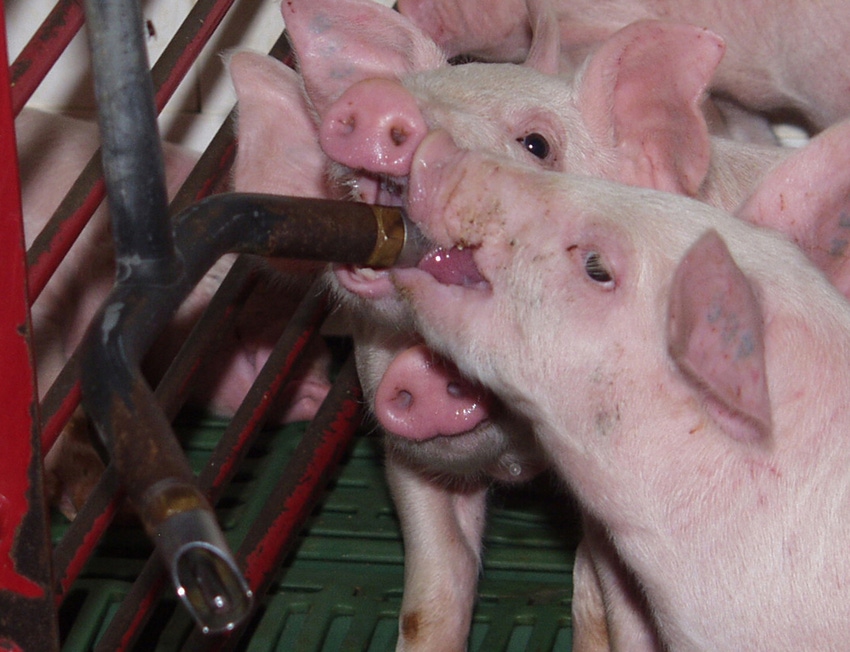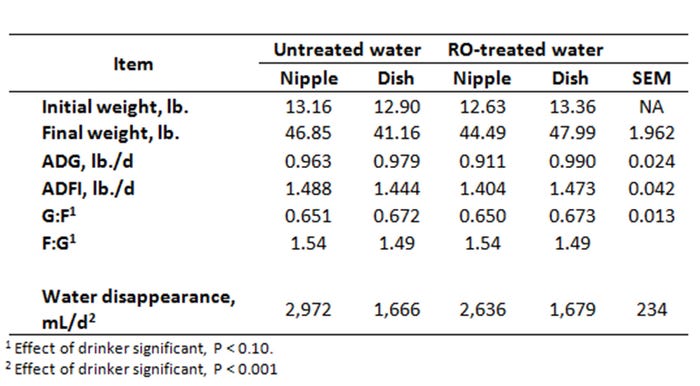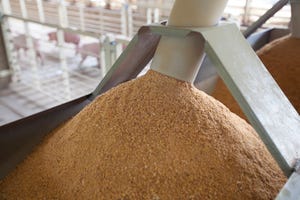Issues with poor growth, feed intake or diarrhea should not be attributed to water quality problems without first exploring other influences, such as environmental, social and nutritional stresses imposed at weaning.
October 26, 2017

By Spenser Becker and John Patience, Iowa State University Department of Animal Science
Successful pork production requires several key factors. One often overlooked aspect is the adequate supply of clean drinking water. Water is an essential requirement for all animals; however it is a particularly difficult nutrient to study.
Multiple contaminants can affect water quality, including microorganisms and high mineral levels, such as sulfate salts. Sulfates are a contributor to the concentration of total dissolved solids in water, which are a common indicator of water quality. Sulfates are of particular concern due to their known ability to induce non-pathogenic diarrhea in weanling pigs. Increased incidences of diarrhea and reduced growth performance has often been attributed to poor water quality; however, research has consistently shown that this is often not the case.
In an article first reported in the Journal of Swine Health and Production1, two experiments were conducted at a 1,200-sow farrow-to-finish commercial farm in order to evaluate the impact of a high sulfate water source on weanling pig growth performance. In the first experiment, 240 pigs weighing 13.0 ± 4.2 pounds received either reverse osmosis (n=14 pens) treated or untreated (raw; n = 14 pens) water for 35 days. Reverse osmosis is the only effective way to remove sulfates from the water. Water was delivered via nipple drinkers or dish-type drinkers. All pigs received supplemental zinc from zinc oxide in their diet. In both experiments, water samples were collected weekly for quality analysis.
The water analysis (Table 1) showed that the untreated water contained concentrations of TDS 15 times greater than the RO-treated water. The sulfate concentrations in the untreated water were consistently 60 to 70% above the recommended levels, while the RO treatment removed approximately 99% of the sulfates in the water.

Table 1: Guidelines for water quality and mean composition of drinking water evaluated in nursery pigs housed in a commercial facility.
At the completion of the 35-day experiment, pigs weighed 46.5 ± 6.8 pounds. For the overall five-week nursery period, average daily gain and average daily feed intake (Table 2) were similar regardless of water treatment or drinker type (P > 0.05). Feed efficiency tended to be higher for pigs utilizing dish-type drinkers than for pigs in pens with nipple drinkers (P < 0.10). There was no interaction of water treatment and drinker type.

Table 2: Effect of water quality and drinker type on growth performance and water disappearance in weanling pigs — Experiment 2
A second experiment was conducted to confirm the results of the first study and to determine if the lack of an impact of high sulfate water was due to inclusion of zinc oxide in the diet. Supplementing weanling pigs’ diet with higher levels of zinc have been shown to improve ADG, possibly because it is controlling pathogenic E coli. Thus, dietary zinc inclusion may contribute to mitigating the expected negative effects of poor water quality.
In Experiment 2, 230 pigs weighing 12.9 ± 2.0 pounds received either untreated (n=14 pens) or RO-treated water (n=14 pens) and were assigned diets supplemented with either zero milligrams (other than that contained in the TM premix) or 3,000 milligrams zinc oxide per kilogram of feed. This study was conducted some time ago; it is now known to not feed this level of zinc for such a long period of time. However, similar to the first experiment, ADG, ADFI and feed efficiency were all comparable regardless of water treatment at the conclusion of the 33-day period (P > 0.05; Table 3). Pigs not supplemented with zinc oxide consumed 0.09 pounds more feed per day (P < 0.05). Pigs consuming zinc-supplemented diets had a lower ADG (P < 0.05), which was most evident among the group receiving untreated water, in which a water treatment-by-zinc interaction was observed. (Days 0 to 21; P < 0.05). Once again, the effect of water quality on performance was minimal.

Table 3: Effect of water quality and zinc oxide supplementation on growth performance in weanling pigs — Experiment 2
These studies demonstrate the capacity of weanling pigs to handle large amounts of sulfates in their drinking water. Pig performance was not adversely affected by poor water quality. Issues with poor growth, feed intake or diarrhea should not be attributed to water quality problems without first exploring other influences, such as environmental, social and nutritional stresses imposed at weaning. Certainly, observing pigs on high sulfate water with diarrhea should not automatically lead to the conclusion that they are performing poorly. Sulfate in the water causes an osmotic diarrhea, which is very different from a secretory diarrhea that might result from pathogens. Based on a large number of studies of various sizes and conducted under a variety of conditions, it appears that unless water is of extremely poor quality, meaning it contains more sulfate than observed in this study, the likelihood of it resulting in poor animal performance is quite low.
A few final points need to be made. First, published water quality standards are often extracted from human guidelines. They do not really apply to livestock, as many of the standards of drinking water are based on aesthetics rather than health; examples include iron, manganese, hardness, turbidity, color, etc. Even levels of sulfates and nitrates are extremely conservative, which is appropriate of course in dealing with drinking water for humans.
Second, while the above research concludes there are no adverse effects from sulfates as high as 1,770 milligrams per liter, if a problem is suspected in a given barn, water should be submitted for analysis including bacteriology. One question that has not yet been answered is whether the osmotic diarrhea created by sulfates leaves the intestinal tract more susceptible to pathogens which could in turn lead to a reduction in animal health and possibly growth performance.
References
1. Patience, J.F., A.D. Beaulieu and D.A. Gillis. 2004. The impact of ground water high in sulphates on the growth performance, nutrient utilization, and tissue mineral levels of pigs housed under commercial conditions. J. Swine Health Prod. 12:228-236.
2. Task Force on Water Quality Guidelines. Canadian Water Quality Guidelines, Inland Waters Directorate, Ottawa, Ontario. 1987.
You May Also Like



